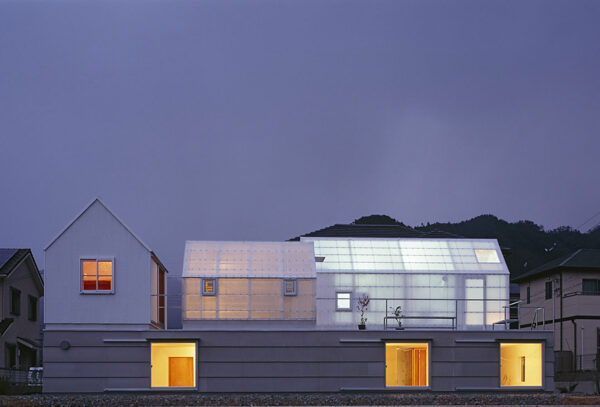
House in Yamasaki by Tato Architects
Located in a cloudy mountain area in the north of Hyogo, this house was designed for a couple and their children. Who wished for a house with a bright and stable indoor climate.
Architects: Tato Architects
Location: Hyogo, Japan
Photography: Ken’ichi Suzuki













On the plot, situated in a new residential area, it was necessary to dig down 760mm before reaching the stable ground. Instead of using columns or other means to support the house, we choose to place the first-floor level 760m below ground. This also opened the opportunity to make a floor heating system utilizing terrestrial heat.
Due to lowering the first level into the ground, the height difference between the outdoor ground level and the rooftop became quite small, and the whole area including the house itself was expected to be used as a garden. The low roof level keeps wide visibility of the surrounding environment, which contributes positively to this new residential area.
The site lies on the border between fields and a newly developed residential area very likely to expand in the future with more buildings. The materials and scale we choose to use, such as corrugated sheets and small volumes resembling agricultural huts, are references to the surrounding rural landscape. Creating a house whose characteristics link the existing landscape to the new residential area.
From the outside, the building is seen as a grey platform 1.8 meters in height, with 3 small archetypical houses on top. The three houses contain a guest room, sanitary space, and a sunroom. The latter two rooms, besides their functions, also provide natural lighting and ventilation to the ground floor, in the way that they work as overhead courtyards spatially connected to the space below.
Especially the sunroom has an impact on the indoor climate, as it collects heat in the winter and brings in fresh air through five motor-operated windows during summer.
As one might assume it isn’t the house-shaped volumes, but the grey podium below them that contains the living space. Being slightly buried in the ground gives the podium volume an offset feeling that creates a certain distance to the neighbors giving privacy and at the same time moves it closer to the exterior – garden and children playing outside. It creates an ambiguous distance –both close and far- in the house.
In this house, a variety of elements merge and relate to each other. In such a design, a certain kind of freedom is created in the rooms, and many things can be brought in and used in everyday life without disturbing the atmosphere of the home.MaterialTwo of the three upper house volumes: the bathroom and the lightroom are covered with translucent corrugated polycarbonate sheets, through which the sunlight can shine and light up the rooms.
The space between the corrugated panels and structural frames is filled with moisture absorbing and heat-retaining sheets that help insulate walls and roofs. The interior polycarbonate walls also work as part of the insulation layer. Furthermore, the remaining space in the walls and roof of the bathroom is filled with light-transmitting thermal insulation made from PET bottles.
To minimize the transition between floor levels, 50mm square pipes were laid out around the openings between both floors. These were sandwiched between floor and ceiling panels creating a total floor thickness of only 80mm.
The openings to the upper level can be closed by a shading device during extremely hot hours in summer and cold nights in winter.
The outer walls of the platform are clad with fiber-reinforced cement boards, overlapping to make rainwater drop off easily and to make shadows that create contrast on the façade.
The concrete foundation is insulated from the outside, and the ground surface around it is covered by gravel to drain rainwater and keep thermal efficiency.